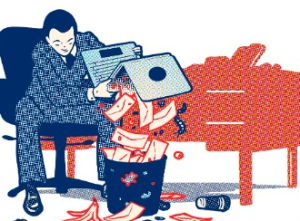Last Updated on July 20, 2020 by John Prendergast
Y our average client’s inbox is buried in 416 commercial emails per month, and some clients in certain professions may get 100-200 per day! No wonder 30% or less are ever even opened.
our average client’s inbox is buried in 416 commercial emails per month, and some clients in certain professions may get 100-200 per day! No wonder 30% or less are ever even opened.
Where are your emails winding up? Do you know? How can you avoid the spam filter and the delete button whether you’re marketing or delivering a key business message?
There are clear ways to break through the clutter, but it’s nothing like you were taught in school ….
When you send your client an email, you want them to be fully engaged in the content. Whether you want to avoid an important message being missed, want to make sure your marketing comes through, you need your message to be seen and understood. So, how can you break through this mess of emails? After delivering hundreds of thousands of emails, we’ve learned a thing or two. Here is what you need to know.
1. Optimize your “headline” like a pro.
Your subject line acts as way to catch your recipient’s attention. Keep it short (25-60 characters). Not only does this make it easier to read, but it just plain works better on mobile. Clients may not even SEE a full subject line on their phone. When writing your ‘headline’, be clear about the topic of your email and title it as if it were a newspaper article. Think about it – a good newspaper headline catches the reader’s attention. “A Flash Mob You’ll Never Believe”, “Why Your Diet is Failing” – you understand the topic of the article, but you get drawn in because you want to know more. But newspapers don’t give it all away in the first line. Use your subject line in the same way. Grab your client’s attention and pull them in. Some good headline formats include:
- Questions – These draw your clients in an almost conversational manner. They’ll be curious how you plan to answer it.
- Surprising Statements – Surprise can easily grab somebody’s attention. Throw in a shocking statistic, or an attention-grabbing statement, and your client will be dying to know more. Use with care though.
- Call to Action – Let your clients know you have a deadline. How do you draw in their attention? State how much time you have left before the deadline, or even ask in the subject line “(Client) – Please Reply By 10/5”
- Ellipsis – This is a popular one at Blueleaf. Use an ellipsis at the end of your headline…and then continue the message inside the email.
2. Keep it short and sweet.
Nobody wants to read a lengthy email. Get to the point, and get rid of the filler. It’s a good rule of thumb to never make an email longer than 5-10 sentences. Within this guide, you can easily fit a most messages. If there is additional information, consider attaching a supporting document (which they have the option of downloading & responding to later). Or you can break the email into 2 parts: a short sweet summary and a full length with all the details below your signature. This way, your emails never ask too much of your client’s time.
3. Choose a single focus
One of the reasons emails start to ramble is because we ramble. Humans aren’t linear thinkers and often don’t start with a very clear focus. Ask yourself, “what is the one thing I need the reader to take away from this email? Don’t send the email unless you can answer that question.
4. Make it easy to read.
Short paragraphs and small words are the rules to live by. Never use a long word when a short one will do. (Thank you Earnest Hemingway) The simpler the words the easier it is to read. Make it scannable. For example, check out the format of this blog post – almost none of the paragraphs have more than 3 or 4 short sentences. Sub-headings and line breaks are frequent. It makes it a breeze to scan quickly.
5. Edit.
Sure, you don’t want any spelling or grammatical errors in your emails. But it’s even more important to edit for focus and structure. Remove unnecessary words and phrases. Kill anything that doesn’t move forward your one idea. Finally, ask if it makes sense. Will the reader really understand what you’re trying to say or have you missed a key idea. These are things you won’t notice the first time you type up the email, so it’s important to give it a second glance before hitting send. Sure the steps are simple but how often have you acted on all of them for a single email? Our experience is that when you do, clients will respond and your business will be better for it.